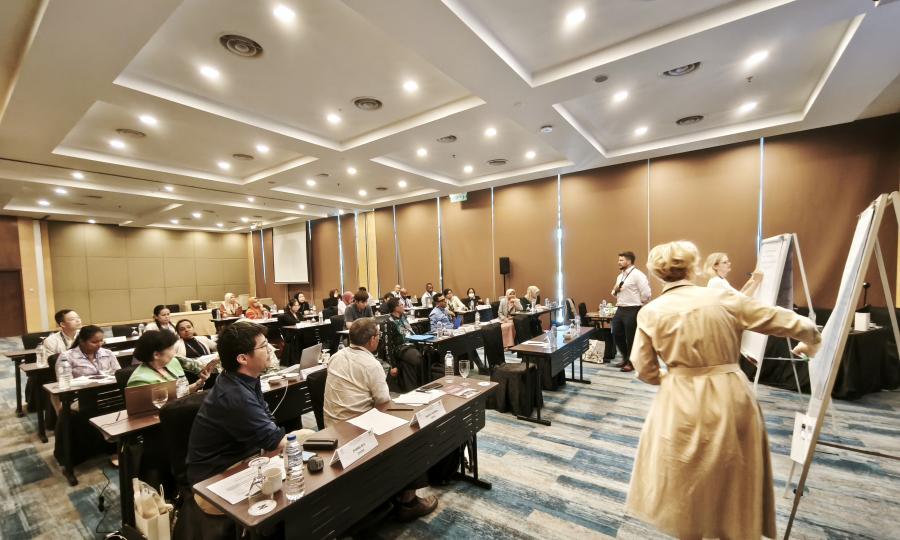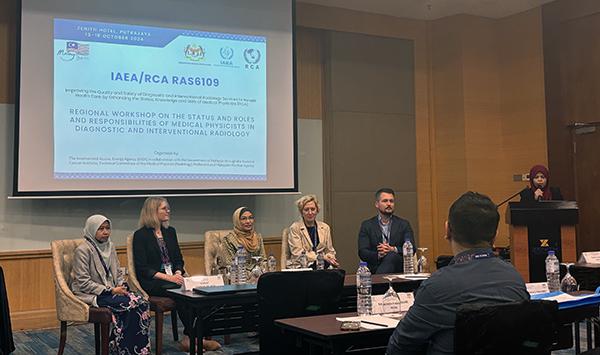The Australian led regional cancer care project in medical physics held its first regional training course in Malaysia to progress Rays of Hope in October 2024. This pivotal regional workshop aimed at strengthening the roles and responsibilities of medical physicists in diagnostic and interventional radiology, was a key milestone in the Regional Cooperative Agreement for Research, Development and Training Related to Nuclear Science and Technology for Asia and the Pacific (RCA) project RAS6109 - Improving the Quality and Safety of Diagnostic and Interventional Radiology Services to Benefit Health Care by Enhancing the Status, Knowledge and Skills of Medical Physicists.
This Australian-led initiative, spearheaded by Dr Ioannis Delakis, Chair of the radiology specialty group, Australasian College of Physical Scientists and Engineers in Medicine (ACPSEM) and Dr Zoe Brady, Chief Physicist (Diagnostic Imaging) and Radiation Safety Officer at the Alfred Hospital in Melbourne and Chair of the ACPSEM Diagnostic Imaging Certification Panel, brought together experts and participants from across Asia and the Pacific. The workshop fostered knowledge exchange and aimed to advance the profession's growth and impact.

The RCA is a treaty level agreement in sharing the peaceful uses of nuclear science and technology in the Asia and Pacific region, which is auspices under the International Atomic Energy Agency (IAEA). ANSTO has responsibility for implementing this treaty on behalf of Australia, which includes working closely with the Australian medical physicists leading this project, Dr Delakis and Dr Brady.
"The workshop was a unique opportunity to unite experts from diverse backgrounds to tackle shared challenges," said Dr Delakis. "By focusing on practical tools like the workforce model and regional survey, we are empowering medical physicists to elevate healthcare standards across Asia and the Pacific."
The workshop, 'Regional Workshop on the Status, Roles, and Responsibilities of Medical Physicists in Diagnostic and Interventional Radiology', spanned four days and served as a hub of collaborative learning and development.
Organised by the IAEA/RCA with significant contributions and leadership from the Malaysian hosts, it brought together 26 participants from RCA member countries and observer nations, including Papua New Guinea. These
professionals included experienced medical physicists, radiology experts, and government representatives, all united by a common goal: enhancing the profession's ability to address regional healthcare challenges.

Central to the workshop was an in-depth exploration of the IAEA's workforce model, designed to assess and meet the evolving needs of medical physicists. Through a combination of lectures, group activities, and interactive sessions, participants examined workforce challenges, methodologies for survey development, and the nuances of medical physics roles across the region.
"Workshops like this are crucial for creating a shared understanding of the profession's evolving needs," added Dr Brady. "It's not just about sharing expertise but also about building sustainable frameworks for future growth and collaboration."
Participants played a key role in shaping a regional survey to capture workforce data and professional perspectives. The survey's questions, meticulously drafted and reviewed during the workshop, aim to establish a comprehensive understanding of the current landscape. This includes identifying workforce gaps, addressing professional challenges, and mapping the roles of medical physicists across diverse healthcare settings.
The collaborative spirit of the event extended beyond the sessions. Malaysian hosts, led by Dr Norzaini Rose Mohd Zain, National Head of Radiology Services, Malaysian Ministry of Health, curated an engaging experience for attendees. From a sightseeing tour of Putrajaya to shared meals, the cultural and professional exchanges enriched the workshop's outcomes. Participants left not only with actionable insights but also as integral members of a robust, newly strengthened regional network, poised to drive future collaboration and growth.
As the workshop concluded, clear next steps emerged. The finalised survey will be launched via the IAEA IRIS platform, with its data shaping future strategies for workforce development and capacity building. This marks a significant milestone in the RAS6109 project, ensuring that medical physicists across the Asia and Pacific region are better equipped to meet the challenges of modern healthcare systems.
The workshop underscored the critical importance of collaboration in advancing medical physics. By addressing knowledge gaps and promoting innovation, it established a robust foundation for the profession's development, reaffirming the IAEA's dedication to improving global healthcare through science and technology while supporting UN Sustainable Development Goals, including Goal 3: Good Health and Well-Being; Goal 4: Quality Education; Goal 5: Gender equality, Goal 10: Reduced Inequality; and Goal 17: Partnerships for the Goals.
Workshop organisers extended their deep appreciation to Malaysia for hosting this important workshop, especially the Malaysia Nuclear Agency and the Malaysian Ministry of Health.
This workshop forms part of the larger RCA portfolio of regional projects in human health, agriculture, environment, and industry.
Ms Natascha Spark, ANSTO's International Affairs Senior Manager said, "ANSTO is pleased to be supporting regional development projects in nuclear science and technology that are having such enormous social and economic impact in our Asia and Pacific region, and we look forward to seeing continued progress in 2025."






